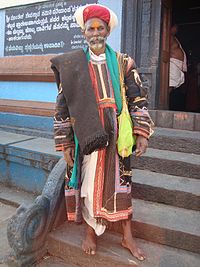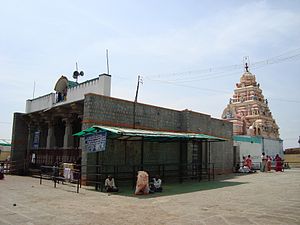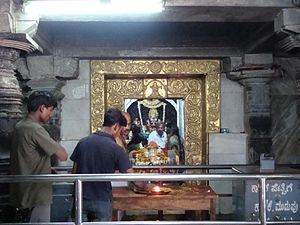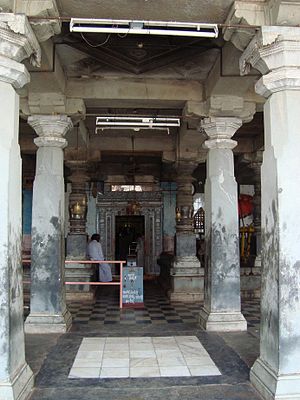- Mylara Lingeshwara Temple at Mylara
-
Mylara Lingeshwara Temple at Mylara
Mylara (Mailara) Lingeshwara Temple at Mylara is in the extreme south-western corner of Hadagali taluk, Bellary District, North Karnataka, India. Situated 2 km from Tungabhadra river and 40 km from Hadagali and 34 km from Ranebennur. Mylara Lingeshwara is one of the forms of Shiva. The temple is dedicated to Shiva worshipped by Kuruba Gowdas in his form as Mailari.
Contents
According to the legend
Mallasura[1] (Demon) and his brother performed a severe penance extracted from Brahma, and a promise that they should never be harmed by any human being, began to harass the sages or rishis. The sages appealed the shiva to protect them, Shiva took on a new form[2] and taking with him his forces to the number of 7 crores goravas, warred with the Demon or Mallasura and his brother, Manikasura for 10 days and then slew them both with his bow. During the battle, Mylara (Shiva) lost his powers and had to run away from the battle field. After a marathon run, Mailari hid himself in the Tungabhadra river. Then Lord Veerabhadra, Shiva's aide struck the earth with his long hair, and five brave warriors (Panchaveeras) (i.e. Kanchaveeras) emerged from the spot. The Kanchaveeras confronted Mallasura and Manikasura and handed them over to Mailara. After killing Mallasura and Manikasura, Mailara (Shiva) wore their intestines as his turban, their teeth as a cowrie necklace, their mouths as a damaruga (hand drum), skulls as a doni (meal bowl) and their skins as a long coat. The fat of the demons was used as oil and their nerves as wick for the lamp.
Karnika Utsava (Prophecy)
Rituals during the Mailara Jatre (fair) include the Karanika Utsava (Bow climbing and prophecy uttering ritual) and Pavada (Body piercing ritual). Karanika Utsava is performed by the Karanika Gorava, who goes through 12 days of fasting, after which he climbs a 12-meter bow and utters a euphoric prophecy regarding regional agriculture, animal husbandry, and politics.
Karnikotsava Gorava's utterance tumbida koda mooru bhaga aadeethale parakh!' means A full pot may get split into three parts. Karnikotsava means the prophecy...it is just like a puzzle to understand... some are guessing it to be an indication of political situation in the state ..and some people guess about rain and crop that means it is an indication of some threat to the agriculture so, the prophecy warns the farmers to be very careful .... ref>"Thus spake Mylara". The Hindu (Chennai, India). 2008-02-29. http://www.hindu.com/fr/2008/02/29/stories/2008022950920100.htm. Retrieved 2008-10-29.</ref>. It is believed that the saying would indicate the future of the coming year.
On Karnikotsava day, the devotees converge to the temple chanting 'elukoti elukoti elukotigo... changmalo changmalo. "Elu koti" means seven crores commemorating the seven crore Goravas who accompanied Mailari. By afternoon, a huge wooden bow, symbolic of that with which Shiva slew Mallasura, is brought and placed in the middle of a vast area called Denkana maradi. The gorava carries the bow from his tent and climbs it up, stares from the top in the four directions, and then begins trembling as a sign of divine inspiration, and the pilgrims wait for his prophecy. Gorava gazes skywards, before pronouncing the annual divination. Soon after this he drops down himself from the bow and the devotees waiting around the bow carefully catch hold of him. The prophecy is believed to be divine truth by the devotees. Management of the Mylar temple is done by wodeyar family. Earlier it was Jayachandra Wodeyar who managed the temple and now it is sri sri sri venkappayya wodeyar on inheritance and Wodeyar family belongs to kshatriya cult. These people are called Guru or Swamy. They are responsible for continuing the pooja, traditions which were carried from past generations..
Goravara Kunita
 Gorava, North Karnataka
Gorava, North Karnataka
Gorava dance (goravara kunita), a dance of the Shiva cult, is popular in areas of North Karnataka. The Goravas[3] worship Mylara linga (Shiva), wear the costume of black woolen rug, on shoulder hanging bag made out of skin. Some of them wear a black coat and white dhoti. In traditional contexts, the Gorava devotees who dance in trance sometimes bark like dogs. It is believed that the totem of the Mylaralinga is a dog. The dancers feet move in clockwise and zigzag forms. Gorava wears yellow powder on his forehead and gives it to his believed devotees. Artiste holds his instrument, like damaru (percussion), or sometime holds kolalu (flute), and a few artists wear a small bronze bell on their shoulders. A few followers hold cowbells called paarigante.
This is years karnika by swami is that "THUMIBDA KODA MOORU BAGHAVADITELYE PARAK" means of that full of water vessel (used for store water) is broken into three parts. - For spiritual meaning that this year crop, politics and family or ambitions of human beings, which effects be careful. On 20 Feb. 2011 mylar jatre was happened there are more than 7-8 lakhs devotees are participate jatra was start from 10 Feb. 2011 to 21 Feb. 2011 on 10th Feb. ratha saptami on 20th Feb. 2011 karnikostava on 21st Feb. 2011 sarapali pavaada this year katnika was AMBALI DUNDAGADEETALE PARAAK.
References
- ^ "Epic Narrative as a Blurred Genre". http://indologyandbeliefsystems.wordpress.com/. Retrieved 2008-10-29.
- ^ "Mailaralinga By M.N.Venkatesha". http://wiki.indianfolklore.org/index.php?title=4._Mailaralinga_By_M.N.Venkatesha. Retrieved 2008-10-29.
- ^ "Professional Religious Singers, Gorava". http://www.webindia123.com/karnataka/ART/music%202.htm. Retrieved 2008-10-29.
Hindu Temples in Karnataka Amrutesvara Temple, Amruthapura • Annapoorneshwari Temple • Annigeri • Antara Gange • Badami Cave Temples • Balligavi • Banashankari Amma Temple • Banashankari Temple Amargol • Bhutanatha group • Chamundeshwari Temple • Chamundeswari Temple • Chandramouleshwara Temple • Chaudayyadanapura • Cheluvanarayana Swamy Temple • Chennakesava Temple • Chennakesava Temple, Somanathapura • Chitrapur Math • Chowdeshwari Temple • Devarayana Durga • Dharmaraya Swamy Temple • Dharmasthala Manjunatha Temple • Dodda Ganeshana Gudi • Doddabasappa Temple Dambal • Gadag-Betigeri • Kalakaleshwara Temple Gajendragad • Galaganatha • Gavi Gangadhareshwara Temple • Godachi • Gokarnanatheshwara Temple • Halasi • Halasuru Someshwara Temple • Hangal • Harihareshwara Temple • Panchalingewara Temple Hooli • Hoysaleswara Temple • Hulimavu cave Temple • Idagunji • Ikkeri • Ishvara Temple, Arasikere • Itagi Bhimambika • Kadri Manjunath Temple • Kalasa • Kalghatgi • Kalikamba Temple • Kamala Narayana Temple Belagavi • Kanakagiri • Karighatta temple • Karikanamma • Kasivisvesvara Temple, Lakkundi • Keladi • Keshava Temple • Kodandarama Temple • Kotilingeshwara • Krauncha Giri • Kudalasangama • Kudroli Bhagavathi • Kukke Subramanya Temple • Kuknur • Kumara Swamy Devasthana, Bangalore • Kundgol • Kurudumale • Lakkundi • Lakshmeshwar • Lakshmi Devi Temple, Doddagaddavalli • Lakshmi Narasimha Temple, Bhadravathi • Lakshmi Narasimha Temple, Nuggehalli • Lakshminarayana Temple, Hosaholalu • Mahabaleshwar Temple, Gokarna • Maha Ganapathi Mahammaya Temple • Mahadeva Temple, Itagi • Mahakuta group of temples • Mandarthi • Mangaladevi Temple • Maranakatte • Mariyamma Temple • Melukote • Mookambika Temple Sirsi • Mudukuthore • Mundkur Sri Durgaparameshwari Temple • Murudeshwara • Mylara Lingeshwara Temple at Mylara • Nandi Temple • Navalinga Temple • Nellitheertha Cave Temple • Padutirupathi • Pattadakal • Ragigudda Anjaneya Temple • Ranganathaswamy Temple, Bangalore • Saundatti • Shree Vishnumurthy Temple • Shri Vinayaka Shankaranarayana Durgamba Temple • Shringeri • Shringeri Sharadamba Temple • Siddhesvara Temple Haveri • Srikanteshwara Temple, Nanjangud •Sirsangi Kalika Temple • Someshwara • Sri Ranganathaswamy Temple, Shivanasamudra • Sri Ranganathaswamy Temple, Srirangapatna • Sudi • Shree Sharavu Sharabheshwara Kshetra- Sri Mahaganapathy Temple • Talagunda • Talakad • Tamboor • Temples in Tulunadu • Temples of North Karnataka • Thirunarayanapuram • Trikuteshwara Temple Gadag • Tripurantaka Temple • Udupi Sri Krishna Matha • Veera Narayana Temple, Belavadi • Virupaksha Temple • Western Chalukya temples • Yediyur Siddhalingeshwara Swamy Temple • Yelluru Shri Vishweshwara Temple
Categories:- Cities and towns in Karnataka
- Hindu temples in Bellary district
- Temples in Karnataka
Wikimedia Foundation. 2010.










